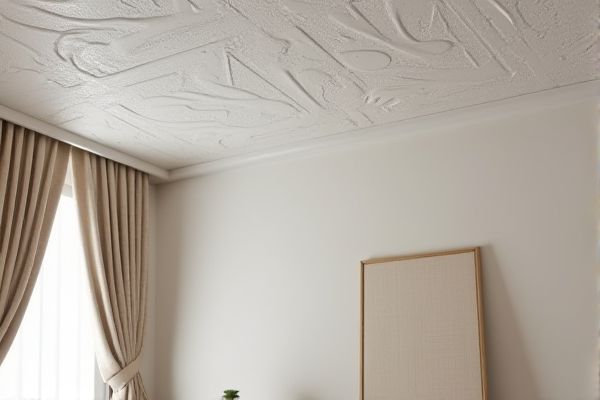
Ceiling tiles provide easy installation, sound absorption, and moisture resistance, making them ideal for commercial spaces, while gypsum boards offer a smooth, paintable surface with excellent fire resistance, suited for residential interiors. To discover which material best fits Your specific needs and enhances your space, continue reading the full article.
Table of Comparison
| Feature | Ceiling Tiles | Gypsum Boards |
|---|---|---|
| Material | Mineral fiber, fiberglass, metal, or plastic | Calcium sulfate dihydrate (gypsum) core with paper facing |
| Installation | Drop-in grid system, easy and quick to replace | Fixed to framing with screws, requires finishing and painting |
| Weight | Lightweight, typically 2-4 lbs per tile | Heavier, approx. 2-3 lbs per square foot |
| Durability | Susceptible to moisture and damage; easy to replace | More durable and moisture-resistant when treated |
| Acoustic Performance | Good sound absorption and noise reduction | Moderate acoustic performance, can be enhanced with insulation |
| Fire Resistance | Varies, some are fire-rated | Generally fire-resistant with Class A rating |
| Cost | Generally lower initial cost | Higher material and labor cost |
| Appearance | Various patterns and textures, modular design | Smooth, seamless finish, customizable with paint or wallpaper |
| Maintenance | Easy to access ceiling voids by removing tiles | Less accessible; requires cutting for access |
Introduction: Ceiling Tiles vs Gypsum Boards
Ceiling tiles offer quick installation, sound absorption, and design flexibility, making them ideal for commercial and acoustic applications. Gypsum boards provide superior fire resistance, durability, and smooth surface finishes preferred in residential and structural walls or ceilings. Your choice depends on factors like budget, installation speed, fire safety, and aesthetic requirements.
Material Composition and Properties
Ceiling tiles are typically made from mineral fiber, fiberglass, or metal, offering lightweight, sound-absorbing, and moisture-resistant properties ideal for commercial spaces. Gypsum boards consist primarily of gypsum plaster sandwiched between paper layers, providing excellent fire resistance, rigidity, and a smooth surface suitable for finishing. Your choice depends on whether you prioritize ease of installation and acoustic performance (ceiling tiles) or structural strength and fire protection (gypsum boards).
Installation Process Comparison
Ceiling tiles offer a quicker and more flexible installation process, often using a suspension grid system that allows easy access for repairs and modifications. Gypsum boards require a more labor-intensive installation involving measuring, cutting, screwing, and taping joints, followed by sanding and finishing to achieve a smooth surface. The choice between ceiling tiles and gypsum boards depends on project timelines, access needs, and desired aesthetic outcomes.
Cost Differences and Budget Considerations
Ceiling tiles typically cost less upfront than gypsum boards, making them a more budget-friendly option for large spaces or temporary installations. Gypsum boards, while more expensive initially, offer greater durability and a smoother finish which can reduce maintenance expenses over time. Your choice between ceiling tiles and gypsum boards should consider both initial costs and long-term budget impacts based on the specific requirements of your project.
Acoustic Performance and Soundproofing
Ceiling tiles generally offer superior acoustic performance compared to gypsum boards, as they are designed to absorb sound and reduce noise levels in a space, making them ideal for offices and commercial environments. Gypsum boards, while offering moderate sound insulation, primarily serve structural and aesthetic purposes and require additional treatments or layers to enhance soundproofing. For optimal acoustic control, ceiling tiles with high Noise Reduction Coefficient (NRC) values outperform standard gypsum boards, which typically have lower Sound Transmission Class (STC) ratings without extra insulation.
Fire Resistance and Safety Features
Ceiling tiles offer excellent fire resistance due to their non-combustible materials, often made from mineral fiber or fiberglass, which can help contain flames and prevent fire spread. Gypsum boards provide superior safety features with a core of chemically combined water that releases steam when heated, effectively slowing down fire penetration and offering enhanced protection. Your choice should consider these fire-retardant properties to ensure optimal safety and compliance with building regulations.
Aesthetic Options and Design Flexibility
Ceiling tiles offer a wide variety of aesthetic options, including diverse patterns, textures, and colors, allowing for creative ceiling designs that can enhance visual appeal. Gypsum boards provide greater design flexibility with the ability to create smooth, seamless surfaces and accommodate custom shapes, curves, and intricate architectural details. Both materials support versatile interior design choices, but gypsum boards excel in delivering modern, minimalist finishes while ceiling tiles are preferred for decorative and modular ceiling solutions.
Maintenance and Durability
Ceiling tiles require regular cleaning and occasional replacement due to susceptibility to moisture and damage, while gypsum boards offer enhanced durability with their resistance to fire, mold, and minor impacts. Gypsum boards generally demand less maintenance over time as they maintain structural integrity and aesthetic appeal longer in various environments. Choosing gypsum boards can reduce long-term costs by minimizing repairs and replacements compared to ceiling tiles.
Applications in Residential and Commercial Spaces
Ceiling tiles offer versatile design options and enhanced acoustic properties, making them ideal for commercial spaces like offices and retail stores where sound control and easy access to utilities are essential. Gypsum boards provide a smooth, seamless finish preferred in residential settings for walls and ceilings, offering fire resistance and durability in living rooms and bedrooms. Your choice depends on whether you prioritize aesthetics and acoustics or structural durability and a polished look in your space.
Conclusion: Choosing the Right Ceiling Solution
Ceiling tiles offer easy installation, enhanced acoustic control, and moisture resistance, making them ideal for commercial spaces or areas prone to humidity. Gypsum boards provide a smooth, seamless finish with superior fire resistance and design flexibility, suited for residential or upscale interiors. Your choice should balance durability, aesthetic preferences, and functional needs to achieve the optimal ceiling solution.
 homyna.com
homyna.com